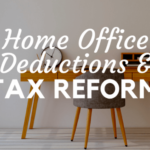Crosstown Commercial Team / April 17, 2019
The Home Office Deduction: Actual Expenses vs. The Simplified Method
If you run your business from your home or perform certain functions at home that are related to your business, you might be able to claim a home office deduction against your business income on your 2018 income tax return…naturally time is running out so you should act quickly or file an extension if applicable to your situation. There are now two methods for claiming this deduction: the Actual Expenses Method and the Simplified Method.
Basics of the deduction
In general, you’ll qualify for a home office deduction if part of your home is used “regularly and exclusively” as your principal place of business.
If your home isn’t your principal place of business, you may still be able to deduct home office expenses if 1) you physically meet with clients, patients, or customers on your premises, or 2) you use a storage area in your home (or a separate free-standing structure, such as a garage) exclusively and regularly for your business.
The Actual Expenses Method
Traditionally, taxpayers have deducted actual expenses when they claim a home office deduction. Deductible home office expenses may include:
- Direct expenses, such as the cost of painting and carpeting a room used exclusively for business;
- A proportionate share of indirect expenses, such as mortgage interest, property taxes, utilities, repairs and insurance, and;
- A depreciation allowance.
But keeping track of actual expenses can be time consuming unless your have the gift of exceptional spreadsheet tracking with regular attention being paid to the process.
The Simplified Method
Fortunately, there’s a simplified method that’s been available since 2013: You can deduct $5 for each square foot of home office space, up to a maximum total of $1,500.
For example, if you’ve converted a 300-square-foot bedroom to an office you use exclusively and regularly for business, you can write off $1,500 under the simplified method (300 square feet x $5). However, if your business is located in a 600-square-foot finished basement, the deduction will still be only $1,500 because of the cap on the deduction under this method. The cap can make the simplified method less beneficial for larger home office spaces. And even for spaces of 300 square feet or less, taxpayers may qualify for a bigger deduction using the actual expense method so tracking your actual expenses can be worth the extra hassle.
Flexibility in filing
When claiming the home office deduction, you’re not locked into a particular method. For instance, you might choose the actual expense method on your 2018 return, use the simplified method when you file your 2019 return next year and then switch back to the actual expense method thereafter. The choice is yours. If you are unsure whether you qualify for the home office deduction or wondering whether you should deduct actual expenses or use the simplified method, find some help. Contact a reputable tax professional who can help you determine what’s right for your specific home office and company situation or Crosstown Commercial associates can recommend a few professionals for you to call.





























